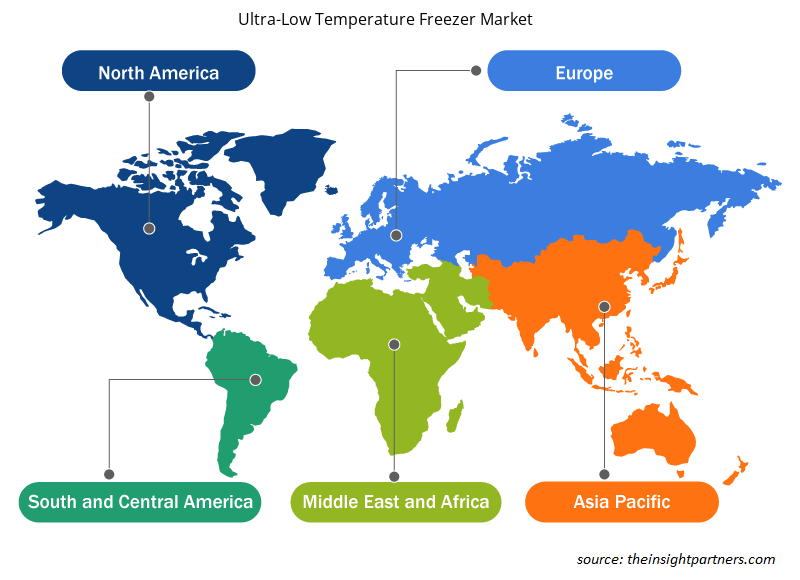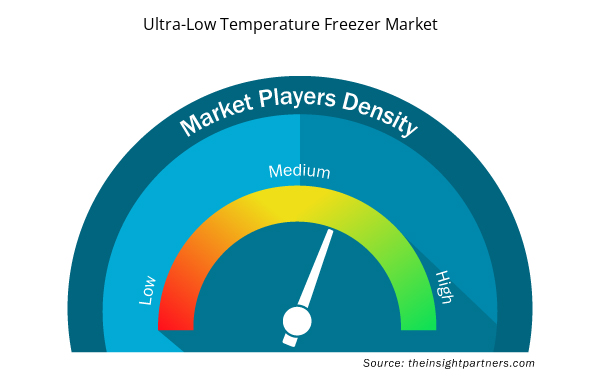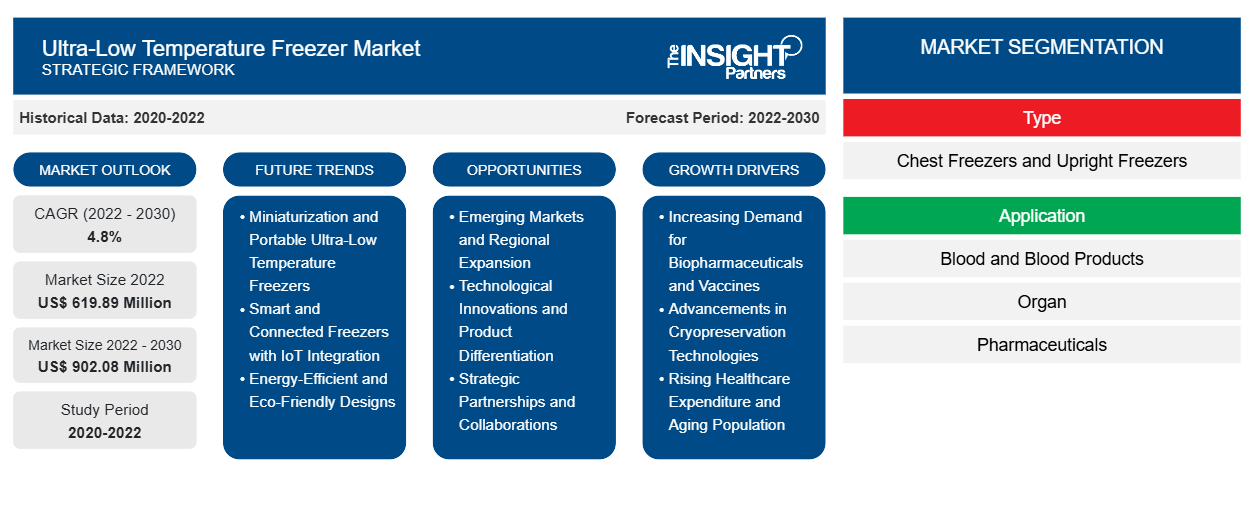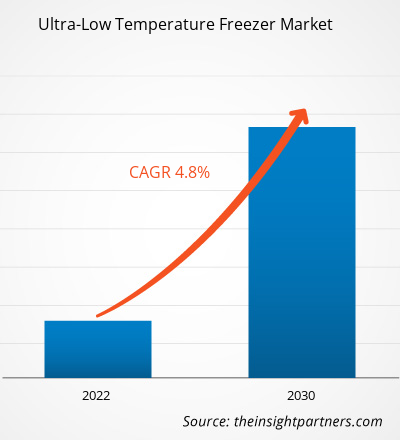[Informe de investigación] Se espera que el mercado de congeladores de temperatura ultrabaja crezca de US$ 619,89 millones en 2022 a US$ 902,08 millones en 2030; se anticipa que registre una CAGR del 4,8% entre 2022 y 2030.
Perspectivas del mercado y opinión de analistas:
El tamaño del mercado de congeladores de temperatura ultrabaja se está expandiendo con el aumento de las actividades de I+D para introducir nuevos compuestos farmacológicos, la creciente demanda de sangre y componentes sanguíneos y el creciente apoyo gubernamental a las actividades de investigación y los ensayos clínicos. Además, la disponibilidad de productos avanzados por parte de los actores del mercado impulsa el crecimiento del mercado. Los congeladores verticales Thermo Scientific Revco RLE -86 °C están disponibles en cinco capacidades, con capacidad para almacenar de 300 a 700 cajas de 2 pulgadas. Estos congeladores brindan un rendimiento térmico, una seguridad y una protección excepcionales.
Factores impulsores del crecimiento y desafíos:
Las muestras de investigación biológica necesitan almacenarse a temperaturas inferiores a -80 °C, es decir, a valores de temperatura ultrabaja (ULT). La función ULT ofrece una alternativa a la tecnología de refrigeración estándar basada en compresores que sigue mejorando a medida que aumenta el conocimiento sobre ella. Los productos innovadores que ofrece Haier Biomedical incluyen congeladores ULT con tecnología de conversión de frecuencia inteligente que cuentan con una cifra de consumo de energía incomparable de solo 8,2 Kwhr/día con una capacidad unitaria de 829 L/29,2 ft3. En octubre de 2022, Thermo Fisher Scientific lanzó un nuevo congelador para su cartera ecológica de temperatura ultrabaja (ULT), el congelador horizontal de -80 °C de la serie TDE de Thermo Scientific. El congelador está alimentado por sistemas de hidrocarburos H-drive y mejora el rendimiento necesario para la investigación vital sin comprometer los objetivos de sostenibilidad. En junio de 2023, el congelador ultrafrío vertical Stirling de BioLife Solutions, clase ISO 6, fue aprobado para aplicaciones de salas blancas de acuerdo con las Buenas Prácticas de Fabricación (BPF) pertinentes, sin comprometer el rendimiento del bioalmacenamiento ni la limpieza del medio ambiente.
Los congeladores de almacenamiento de muestras ULT son un componente crucial de muchos biobancos , clínicas y laboratorios en todo el mundo. Estas unidades permiten una amplia variedad de muestras biológicas, incluyendo ADN, ARN, proteínas y extractos de células. Se requiere un suministro de energía constante para mantener niveles bajos de temperatura. El Instituto Internacional de Laboratorios Sostenibles afirmó que el congelador ULT promedio consume la misma cantidad de energía, 20 kWh por día, que una casa unifamiliar. Teniendo en cuenta que los laboratorios y las instalaciones de investigación suelen utilizar docenas de estas unidades a la vez, los costos operativos y de energía pueden dominar las preferencias del usuario. El precio promedio de funcionamiento de un congelador ULT mecánico vertical puede variar de US$ 750 (£ 570) a US$ 1.000 (£ 750) por año, dependiendo de varios factores como el tamaño y el rango de temperatura. El mantenimiento regular y el mantenimiento en forma de descongelación pueden reducir este costo considerablemente. Además, las cifras mencionadas anteriormente sobre los congeladores ULT no consideran el costo adicional de los sistemas HVAC y la eliminación de aire caliente. Por lo tanto, los altos costos asociados con los congeladores ULT se convierten en una preocupación grave para los laboratorios e instalaciones de almacenamiento que cuidan su presupuesto.
Personalice este informe según sus necesidades
Obtendrá personalización en cualquier informe, sin cargo, incluidas partes de este informe o análisis a nivel de país, paquete de datos de Excel, así como también grandes ofertas y descuentos para empresas emergentes y universidades.
- Obtenga las principales tendencias clave del mercado de este informe.Esta muestra GRATUITA incluirá análisis de datos, desde tendencias del mercado hasta estimaciones y pronósticos.
Segmentación y alcance del informe:
El mercado de congeladores de temperatura ultrabaja está segmentado en función del tipo, la aplicación, la tecnología y la geografía. El mercado de congeladores de temperatura ultrabaja está segmentado en función del tipo, la aplicación, la tecnología y la geografía. El mercado de congeladores de temperatura ultrabaja, por aplicación, está segmentado en sangre y productos sanguíneos, órganos, productos farmacéuticos, investigación forense y genómica, y otros. El mercado, por tecnología, se bifurca en automático y semiautomático.
Según la geografía, el mercado de congeladores de temperatura ultrabaja está segmentado en América del Norte (EE. UU., Canadá y México), Europa (Reino Unido, Alemania, Francia, Italia, España, Rusia y resto de Europa), Asia Pacífico (China, Japón, India, Corea del Sur, Australia, Sudeste Asiático y resto de Asia Pacífico), Medio Oriente y África (EAU, Arabia Saudita, Sudáfrica y resto de Medio Oriente y África) y América del Sur y Central (Brasil, Argentina y resto de América del Sur y Central).
Análisis segmental:
El mercado de congeladores de temperatura ultrabaja, por tipo, se bifurca en congeladores horizontales y congeladores verticales. En 2022, el segmento de congeladores verticales tuvo una mayor participación de mercado, y se espera que el mismo segmento registre una CAGR más alta durante 2022-2030. El crecimiento del mercado proyectado para el segmento de congeladores verticales se atribuye a ventajas como el diseño compacto, la facilidad de organización y la disponibilidad de varias características de seguridad. Además, el aumento de la tasa de adopción debido a los avances tecnológicos que conducen a una mejor supervisión de las operaciones y la facilidad aumentaría el crecimiento del mercado de congeladores de temperatura ultrabaja para el segmento vertical durante el período de pronóstico.
Análisis regional:
Según la geografía, el mercado de congeladores de temperatura ultrabaja está segmentado en América del Norte, Europa, Asia Pacífico, Oriente Medio y África, y América del Sur y Central. América del Norte es el mayor contribuyente al crecimiento del mercado mundial de congeladores de temperatura ultrabaja. Se espera que Asia Pacífico registre la CAGR más alta en el mercado de congeladores de temperatura ultrabaja durante 2022-2030. El crecimiento del mercado de congeladores de temperatura ultrabaja en los EE. UU. está impulsado principalmente por la creciente prevalencia del cáncer de pulmón, los lanzamientos de productos y las iniciativas gubernamentales. La creciente demanda de biobancos aporta un potencial transformador a los sistemas sanitarios y económicos de los EE. UU. Sin embargo, el enfoque inmediato de los biobancos en rápido desarrollo en el país se ve incrementado por la necesidad de comprender las enfermedades, descubrir y desarrollar fármacos. Además, la investigación de los biobancos proporciona nuevos conocimientos sobre el componente genético de las enfermedades humanas, que se centra en el desarrollo de un enfoque automatizado y más personalizado de la atención sanitaria. Además, varios actores del mercado en los EE. UU. se centran en ofrecer una cartera diversificada y de vanguardia de productos y servicios de biobancos diseñados para acelerar los descubrimientos que salvan vidas. El creciente número de actividades comerciales entre los actores del mercado está contribuyendo dinámicamente al crecimiento del mercado. En noviembre de 2020, los hospitales de los estados y ciudades de EE. UU. luchaban por comprar congeladores ultrafríos que pudieran almacenar de forma segura la vacuna PFE.N COVID-19 de Pfizer Inc., ignorando el consejo de los Centros para el Control y la Prevención de Enfermedades (CDC) de EE. UU. de esperar.
Perspectivas regionales del mercado de congeladores de temperatura ultrabaja
Los analistas de Insight Partners explicaron en detalle las tendencias y los factores regionales que influyen en el mercado de congeladores de temperatura ultrabaja durante el período de pronóstico. Esta sección también analiza los segmentos y la geografía del mercado de congeladores de temperatura ultrabaja en América del Norte, Europa, Asia Pacífico, Oriente Medio y África, y América del Sur y Central.

- Obtenga datos regionales específicos para el mercado de congeladores de temperatura ultrabaja
Alcance del informe de mercado de congeladores de temperatura ultrabaja
| Atributo del informe | Detalles |
|---|---|
| Tamaño del mercado en 2022 | US$ 619,89 millones |
| Tamaño del mercado en 2030 | US$ 902,08 millones |
| CAGR global (2022-2030) | 4,8% |
| Datos históricos | 2020-2022 |
| Período de pronóstico | 2022-2030 |
| Segmentos cubiertos | Por tipo
|
| Regiones y países cubiertos | América del norte
|
| Líderes del mercado y perfiles de empresas clave |
|
Densidad de actores del mercado: comprensión de su impacto en la dinámica empresarial
El mercado de congeladores de temperatura ultrabaja está creciendo rápidamente, impulsado por la creciente demanda de los usuarios finales debido a factores como la evolución de las preferencias de los consumidores, los avances tecnológicos y una mayor conciencia de los beneficios del producto. A medida que aumenta la demanda, las empresas amplían sus ofertas, innovan para satisfacer las necesidades de los consumidores y aprovechan las tendencias emergentes, lo que impulsa aún más el crecimiento del mercado.
La densidad de actores del mercado se refiere a la distribución de las empresas o firmas que operan dentro de un mercado o industria en particular. Indica cuántos competidores (actores del mercado) están presentes en un espacio de mercado determinado en relación con su tamaño o valor total de mercado.
Las principales empresas que operan en el mercado de congeladores de temperatura ultrabaja son:
- Thermo Fisher Scientific Inc
- Grupo Godrej
- Corporación del grupo Haier
- Estrella azul limitada
- Helmer Scientific Inc
Descargo de responsabilidad : Las empresas enumeradas anteriormente no están clasificadas en ningún orden particular.

- Obtenga una descripción general de los principales actores clave del mercado de congeladores de temperatura ultrabaja
Desarrollos industriales y oportunidades futuras:
A continuación se enumeran varias iniciativas de actores clave que operan en el mercado de congeladores de temperatura ultrabaja:
- En mayo de 2023, PHC Corporation of North America (PHCNA) anunció que el congelador de temperatura ultrabaja VIP ECO SMART de la marca PHCbi había recibido el prestigioso premio al producto nuevo destacado de 2023 de la Sociedad Internacional de Repositorios Biológicos y Ambientales (ISBER). El producto está diseñado para su uso en una variedad de instalaciones, como universidades, instituciones médicas y empresas farmacéuticas .
- En febrero de 2023, PHC Corporation of North America (PHCNA) lanzó la serie de congeladores de temperatura ultrabaja VIP ECO SMART de la marca PHCbi. Esta nueva serie se basa en congeladores de temperatura ultrabaja innovadores y confiables para ofrecer un rendimiento de ahorro de energía mejorado al tiempo que mejora la seguridad y la facilidad de uso.
Panorama competitivo y empresas clave:
Thermo Fisher Scientific Inc, Godrej Group, Haier Group Corporation, Blue Star Limited, Helmer Scientific Inc, PHC Holdings, BioLife Solutions Inc, Eppendorf SE, Meling Biomedical y Arctiko se encuentran entre los actores destacados que operan en el mercado de congeladores de temperatura ultrabaja. Estas empresas se centran en el lanzamiento de nuevos productos y en las expansiones geográficas para satisfacer la creciente demanda de los consumidores en todo el mundo y aumentar su gama de productos en carteras especializadas. Su presencia global les permite atender a una gran base de clientes, lo que facilita posteriormente la expansión del mercado.
- Análisis histórico (2 años), año base, pronóstico (7 años) con CAGR
- Análisis PEST y FODA
- Tamaño del mercado Valor/volumen: global, regional, nacional
- Industria y panorama competitivo
- Conjunto de datos de Excel


- Intraoperative Neuromonitoring Market
- Sports Technology Market
- Vessel Monitoring System Market
- Space Situational Awareness (SSA) Market
- Adaptive Traffic Control System Market
- Arterial Blood Gas Kits Market
- Transdermal Drug Delivery System Market
- Unit Heater Market
- Railway Braking System Market
- Helicopters Market

Report Coverage
Revenue forecast, Company Analysis, Industry landscape, Growth factors, and Trends

Segment Covered
This text is related
to segments covered.

Regional Scope
North America, Europe, Asia Pacific, Middle East & Africa, South & Central America

Country Scope
This text is related
to country scope.
Preguntas frecuentes
The increasing demand for blood and blood components, and technological advancements in ultra-low temperature freezer bolster the ultra-low temperature freezer market size. However, the high cost associated with ultra-low temperature freezer hinders the ultra-low temperature freezer market growth.
Based on geography, the ultra-low temperature freezer market is segmented into North America (the US, Canada, and Mexico), Europe (the UK, Germany, France, Italy, Spain, and the Rest of Europe), Asia Pacific (China, Japan, India, South Korea, Australia, and the Rest of Asia Pacific), the Middle East & Africa (the UAE, Saudi Arabia, South Africa, and Rest of the Middle East & Africa), and South & Central America (Brazil, Argentina, and the Rest of South & Central America). North America is the largest contributor to the growth of the global ultra-low temperature freezer market. Asia Pacific is expected to register the highest CAGR in the ultra-low temperature freezer market during 2022–2030.
The ultra-low temperature freezer market is divided on the basis of type, application, and technology. The ultra-low temperature freezer market, by type, is bifurcated into chest freezers and upright freezers. In 2022, the upright segment held a larger market share. Further, the upright segment is expected to record a faster CAGR during 2022–2030.
The ultra-low temperature freezer market, by application, is segmented into blood & blood products, organs, pharmaceuticals, forensic & genomic research, and others. In 2022, the blood & blood products segment held a largest market share. Further, the pharmaceuticals segment is expected to record a fastest CAGR during 2022–2030.
The market, by technology, is bifurcated into automatic and semi-automatic. In 2022, the automatic segment held a larger market share. Further, the automatic segment is expected to record a faster CAGR during 2022–2030.
Ultra-Low temperature freezers are designed to store biological materials such as viruses, bacteria, eukaryotic cells, blood, and semen. These freezers are used in blood banks, hospitals, epidemic prevention services, research institutes, and biomedical engineering facilities. These are available in different specifications to suit specific commercial needs. For instance, the plasma once is used for storage of blood and plasma products at -30°C to 40°C, and the ultra-low temperature freezers are used for long term storage of DNA and RNA samples products at a range of 70°C to 80 °C.
The ultra-low temperature freezer market majorly consists of the players such Thermo Fisher Scientific Inc, Godrej Group, Haier Group Corporation, Blue Star Limited, Helmer Scientific Inc, PHC Holdings, BioLife Solutions Inc, Eppendorf SE, Meling Biomedical, and Arctiko among others.
Trends and growth analysis reports related to Life Sciences : READ MORE..
The List of Companies - Ultra-Low Temperature Freezer Market
- Thermo Fisher Scientific Inc
- Godrej Group
- Haier Group Corporation
- Blue Star Limited
- Helmer Scientific Inc
- PHC Holdings
- BioLife Solutions Inc
- Eppendorf SE
- Meling Biomedical
- Arctiko
The Insight Partners performs research in 4 major stages: Data Collection & Secondary Research, Primary Research, Data Analysis and Data Triangulation & Final Review.
- Data Collection and Secondary Research:
As a market research and consulting firm operating from a decade, we have published and advised several client across the globe. First step for any study will start with an assessment of currently available data and insights from existing reports. Further, historical and current market information is collected from Investor Presentations, Annual Reports, SEC Filings, etc., and other information related to company’s performance and market positioning are gathered from Paid Databases (Factiva, Hoovers, and Reuters) and various other publications available in public domain.
Several associations trade associates, technical forums, institutes, societies and organization are accessed to gain technical as well as market related insights through their publications such as research papers, blogs and press releases related to the studies are referred to get cues about the market. Further, white papers, journals, magazines, and other news articles published in last 3 years are scrutinized and analyzed to understand the current market trends.
- Primary Research:
The primarily interview analysis comprise of data obtained from industry participants interview and answers to survey questions gathered by in-house primary team.
For primary research, interviews are conducted with industry experts/CEOs/Marketing Managers/VPs/Subject Matter Experts from both demand and supply side to get a 360-degree view of the market. The primary team conducts several interviews based on the complexity of the markets to understand the various market trends and dynamics which makes research more credible and precise.
A typical research interview fulfils the following functions:
- Provides first-hand information on the market size, market trends, growth trends, competitive landscape, and outlook
- Validates and strengthens in-house secondary research findings
- Develops the analysis team’s expertise and market understanding
Primary research involves email interactions and telephone interviews for each market, category, segment, and sub-segment across geographies. The participants who typically take part in such a process include, but are not limited to:
- Industry participants: VPs, business development managers, market intelligence managers and national sales managers
- Outside experts: Valuation experts, research analysts and key opinion leaders specializing in the electronics and semiconductor industry.
Below is the breakup of our primary respondents by company, designation, and region:

Once we receive the confirmation from primary research sources or primary respondents, we finalize the base year market estimation and forecast the data as per the macroeconomic and microeconomic factors assessed during data collection.
- Data Analysis:
Once data is validated through both secondary as well as primary respondents, we finalize the market estimations by hypothesis formulation and factor analysis at regional and country level.
- Macro-Economic Factor Analysis:
We analyse macroeconomic indicators such the gross domestic product (GDP), increase in the demand for goods and services across industries, technological advancement, regional economic growth, governmental policies, the influence of COVID-19, PEST analysis, and other aspects. This analysis aids in setting benchmarks for various nations/regions and approximating market splits. Additionally, the general trend of the aforementioned components aid in determining the market's development possibilities.
- Country Level Data:
Various factors that are especially aligned to the country are taken into account to determine the market size for a certain area and country, including the presence of vendors, such as headquarters and offices, the country's GDP, demand patterns, and industry growth. To comprehend the market dynamics for the nation, a number of growth variables, inhibitors, application areas, and current market trends are researched. The aforementioned elements aid in determining the country's overall market's growth potential.
- Company Profile:
The “Table of Contents” is formulated by listing and analyzing more than 25 - 30 companies operating in the market ecosystem across geographies. However, we profile only 10 companies as a standard practice in our syndicate reports. These 10 companies comprise leading, emerging, and regional players. Nonetheless, our analysis is not restricted to the 10 listed companies, we also analyze other companies present in the market to develop a holistic view and understand the prevailing trends. The “Company Profiles” section in the report covers key facts, business description, products & services, financial information, SWOT analysis, and key developments. The financial information presented is extracted from the annual reports and official documents of the publicly listed companies. Upon collecting the information for the sections of respective companies, we verify them via various primary sources and then compile the data in respective company profiles. The company level information helps us in deriving the base number as well as in forecasting the market size.
- Developing Base Number:
Aggregation of sales statistics (2020-2022) and macro-economic factor, and other secondary and primary research insights are utilized to arrive at base number and related market shares for 2022. The data gaps are identified in this step and relevant market data is analyzed, collected from paid primary interviews or databases. On finalizing the base year market size, forecasts are developed on the basis of macro-economic, industry and market growth factors and company level analysis.
- Data Triangulation and Final Review:
The market findings and base year market size calculations are validated from supply as well as demand side. Demand side validations are based on macro-economic factor analysis and benchmarks for respective regions and countries. In case of supply side validations, revenues of major companies are estimated (in case not available) based on industry benchmark, approximate number of employees, product portfolio, and primary interviews revenues are gathered. Further revenue from target product/service segment is assessed to avoid overshooting of market statistics. In case of heavy deviations between supply and demand side values, all thes steps are repeated to achieve synchronization.
We follow an iterative model, wherein we share our research findings with Subject Matter Experts (SME’s) and Key Opinion Leaders (KOLs) until consensus view of the market is not formulated – this model negates any drastic deviation in the opinions of experts. Only validated and universally acceptable research findings are quoted in our reports.
We have important check points that we use to validate our research findings – which we call – data triangulation, where we validate the information, we generate from secondary sources with primary interviews and then we re-validate with our internal data bases and Subject matter experts. This comprehensive model enables us to deliver high quality, reliable data in shortest possible time.


 Obtenga una muestra gratuita de este informe
Obtenga una muestra gratuita de este informe